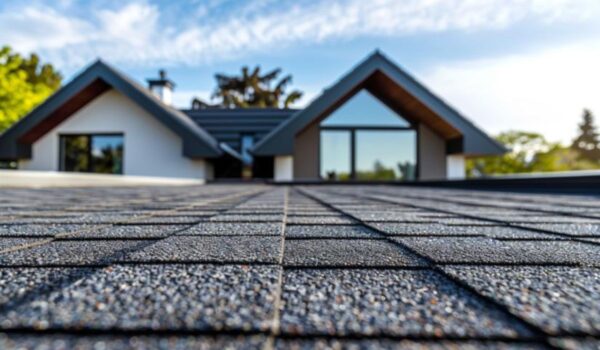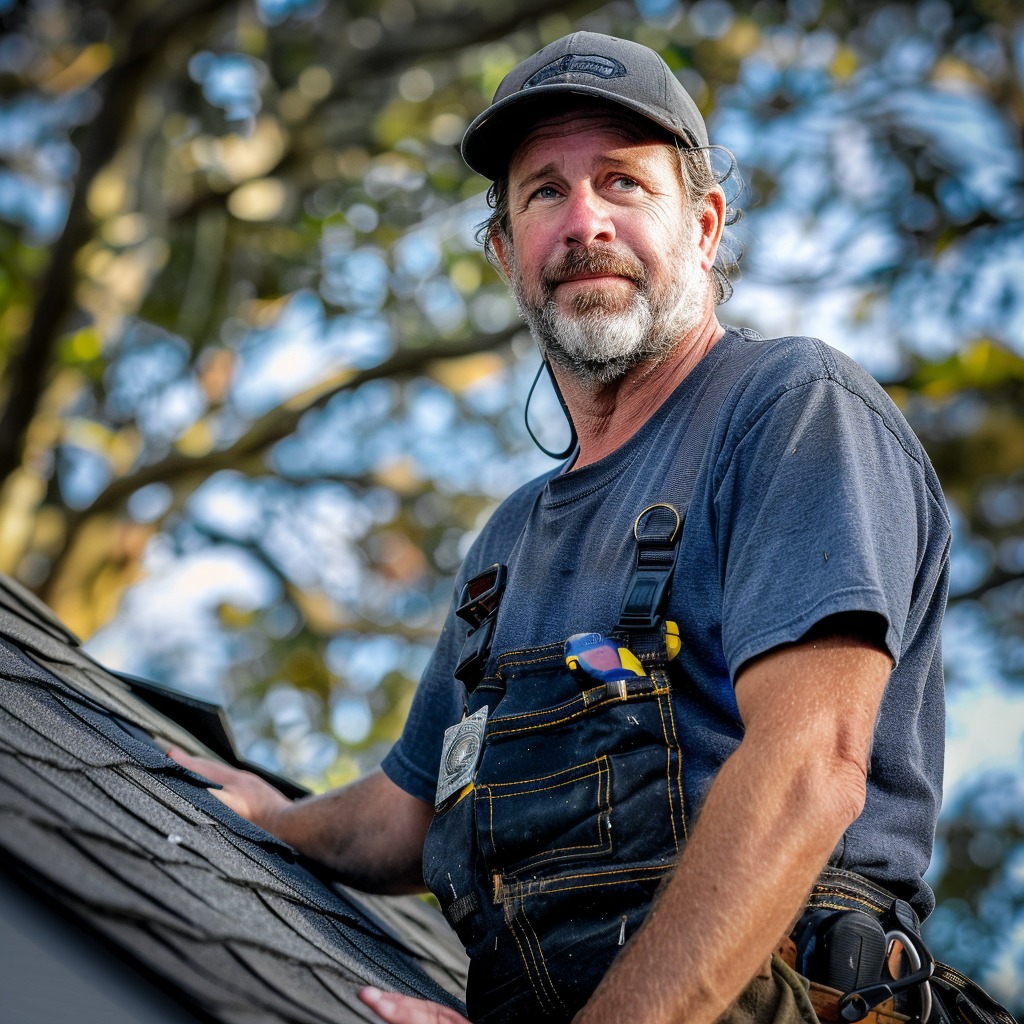
When it comes to flat roof replacements, homeowners often face the challenge of choosing the right materials. Flat roofs require special consideration due to their unique design and potential for water pooling. But fear not, because we are here to guide you through the process and help you make an informed decision. In this article, we will explore the most popular and durable flat roof shingle options available on the market today.
With so many choices available, it’s crucial to understand the advantages and considerations of each material. From EPDM membrane roofing to TPO membrane roofing, PVC membrane roofing, and standing seam metal roofs, we will delve into the unique properties of each option. So, which flat roof shingle should you choose? Let’s dive in and find out!
Key Takeaways:
- Different materials offer unique advantages when it comes to flat roof shingles.
- EPDM membrane roofing is extremely durable but may have heat absorption concerns.
- TPO membrane roofing reflects heat and is suitable for flat roofs over living spaces.
- PVC membrane roofing is similar to TPO but may require regular inspections.
- Standing seam metal roofs combine durability and aesthetics for flat roofs.
EPDM Membrane Roofing
EPDM (ethylene propylene diene terpolymer) is a synthetic rubber black membrane that is commonly used in commercial and residential roofing. It offers numerous benefits for flat roof installations, making it a popular choice among homeowners and contractors.
One of the key advantages of EPDM membrane roofing is its durability. When properly installed and maintained, EPDM roofs can last between 25 and 30 years, providing long-term protection for your home or building. This exceptional durability ensures that you won’t have to worry about frequent repairs or replacements, saving you both time and money in the long run.
EPDM is primarily used in commercial buildings, but it can also be an excellent option for flat roofs over non-living spaces, such as garages or storage sheds. Its resistance to punctures and tears makes it ideal for areas with minimal foot traffic.
However, it’s important to note that the black color of EPDM membranes can absorb heat, which may not be ideal for flat roofs over bedrooms or living spaces. To reduce heat absorption and maintain a comfortable indoor environment, consider applying a light-colored coating or using other insulation methods.
With its exceptional durability and versatility, EPDM membrane roofing offers numerous benefits for flat roof installations. Whether you’re looking to replace an existing flat roof or are considering a new construction project, EPDM is a reliable choice that will provide long-lasting protection for your property.
TPO Membrane Roofing
When it comes to choosing the right material for your flat roof, TPO membrane roofing is a top contender. TPO, short for thermoplastic polyolefin, is a single-ply white membrane that offers numerous benefits for both commercial and residential roofing applications.
One of the key advantages of TPO membrane roofing is its ability to reflect heat instead of absorb it. This makes it an excellent choice for flat roofs over bedrooms or living spaces, where temperature control is crucial. By reflecting sunlight, TPO helps to keep the interior of your home cooler, reducing the need for excessive air conditioning and ultimately lowering energy costs.
TPO roofs are also known for their durability. When properly installed and maintained, TPO membrane roofing can last up to 25 years. However, it is important to note that regular inspections are necessary to identify and address any potential leaks or damage that may occur over time.
Another advantage of TPO membrane roofing is its versatility. It can be installed on various types of flat roofs, making it a popular choice for both commercial and residential properties. Its flexibility allows it to accommodate the expansion and contraction that occur with temperature changes, ensuring long-lasting performance.
Overall, TPO membrane roofing is a reliable and cost-effective option for flat roofs. Its ability to reflect heat, durability, and versatility make it an excellent choice for homeowners who value energy efficiency, longevity, and peace of mind.
PVC Membrane Roofing
PVC (polyvinyl chloride) is another single-ply white membrane used in commercial and residential roofing. It offers a durable and long-lasting solution for flat roofs, making it a popular choice among homeowners and contractors alike. PVC roofs are known for their exceptional durability, with a lifespan of up to 25 years when properly installed and maintained.
One of the key benefits of PVC membrane roofing is its exceptional resistance to UV rays, chemicals, and weathering. This makes it highly suitable for flat roofs exposed to harsh climatic conditions. Additionally, PVC membranes are highly flexible and can accommodate the movement of the building, preventing cracks and leaks.
Like TPO membrane roofing, PVC roofs are installed using a hot air welding technique, ensuring a secure and watertight bond. This installation method eliminates the need for adhesives or other materials that may deteriorate over time, enhancing the overall durability of the roof.
The Many Benefits of PVC Membrane Roofing
“PVC membrane roofing provides superior durability and weather resistance for flat roofs, offering long-term protection and peace of mind to homeowners.”
PVC membrane roofing offers several benefits that make it an attractive option for flat roofs:
- Exceptional Durability: PVC roofs can withstand extreme weather conditions, including high winds, heavy rain, and hail.
- Energy Efficiency: The white color of PVC membranes reflects sunlight, reducing the heat absorbed by the roof. This can lead to lower cooling costs during the hot summer months.
- Low Maintenance: PVC roofs require minimal maintenance, making them a practical choice for homeowners seeking hassle-free roofing solutions.
- Fire Resistance: PVC membranes have excellent fire-resistant properties, providing an added layer of safety for your home.
- Environmentally Friendly: PVC roofing materials are recyclable, contributing to sustainable building practices.
When it comes to flat roof shingle options, PVC membrane roofing stands out for its durability, longevity, and weather resistance. Whether you have a residential or commercial property, choosing PVC membrane roofing can provide you with a reliable and long-lasting solution for your flat roof needs.
Standing Seam Metal Roof
A standing seam metal roof is an excellent choice for homeowners looking for a durable and long-lasting solution for their flat roofs. This type of roof consists of metal panels that are locked together at the seams, providing exceptional strength and durability.
One of the key advantages of a standing seam metal roof is its impressive lifespan. Under ideal conditions, these roofs can easily last up to 30 years, and in some cases, even up to 50 years. This longevity makes them a cost-effective option in the long run, as they require minimal maintenance and replacement costs compared to other flat roof materials.
In addition to their durability, standing seam metal roofs offer several other benefits. They are highly resistant to extreme weather conditions, such as heavy rain, hail, and snow. The interlocking seams prevent water penetration, reducing the risk of leaks and water damage. This makes them a reliable choice for homeowners seeking robust protection for their flat roofs.
While standing seam metal roofs offer exceptional durability, it’s important to note that they are more expensive compared to membrane roofs. Additionally, the installation process can be more complex and requires professional expertise. However, for homeowners who prioritize longevity and the aesthetic appeal of a metal roof, a standing seam metal roof is an investment that can provide peace of mind and enhance the overall value of their property.
Source Links
- https://www.billraganroofing.com/blog/best-material-for-flat-roof
- https://www.karnakcorp.com/blog/what-are-the-different-options-for-roofing-materials-on-a-flat-roof
- https://www.fixr.com/articles/best-flat-roof-materials

Meet William Adams, a seasoned roofing expert with over 30 years of hands-on experience in the industry. Having worked tirelessly under the scorching sun and through the fiercest storms, William brings a wealth of knowledge and expertise to the table. Hailing from the heart of the USA, he’s witnessed the evolution of roofing practices firsthand, mastering every aspect along the way. Now retired from the field, William spends his days cherishing time with his loved ones while sharing his invaluable insights through this platform. With William at the helm, you can trust that every tip, advice, and recommendation provided is backed by years of real-world experience and unwavering dedication to quality craftsmanship. Join us as we journey through the world of roofing, guided by the wisdom and passion of a true industry veteran.
